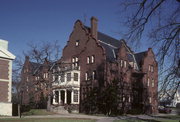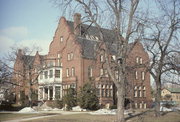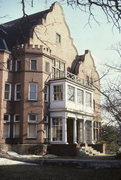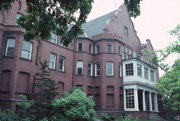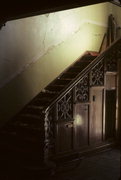| Additional Information: | A 'site file' exists for this property. It contains additional information such as correspondence, newspaper clippings, or historical information. It is a public record and may be viewed in person at the Wisconsin Historical Society, State Historic Preservation Office.
Emerson Hall, located at the northeast corner of the Beloit College campus, is architecturally significant as representing a type and period of construction. Built in 1897 by the Chicago architectural firm of Patton and Fisher, the brick building reflects elements of the exuberant and elaborately detailed "Jacobethan" style, a phase of the eclectic revival favored by academic institutions at the turn of the century. The variety of its massing is apparent in its dimensions: the outside dimensions of the main block are 138 feet (north-south, including pentagonal bays) by 36 feet at its narrowest width or 57 feet at its widest, where bays project. A one-story wing of ca. 23 feet by 30 feet extends to the rear. The two bays near the southwest corner are one story high; the center west and east bays, and the northwest and northeast corner bays are all two stories high; and the two intersecting bays north of the entrance, one of which is polygonal and crennelated, are three stories high. The bulk of the building is three stories high with attic story. Yet the long and relatively narrow building seems taller and broader than its dimensions indicate because the complexity of its varied surfaces and stories create the impression of broken masses rising to substantial heights. The steeply pitched and intersecting gables, the curved and angular parapets, the bays, turrets, and chimneys all add to the building's richly varied profile. Terra cotta coping and courses and mullioned windows further enhance the Jaobean flavor of the building and add to its striking eclecticism.
Emerson Hall was constructed in 1897 as an early dormitory for women on the Beloit College campus. Funded by donations from several families, the hall "marked a new era for the young women of the college," according to College president E.D. Eaton, "giving a dignified setting to their lives."
That setting included not only the elaborately detailed "Jacobean" exterior, but reception rooms, dining rooms, maid service, a gymnasium, and the protective presence of a college matron. Although college housing was built to the south and west throughout the 20th century. Emerson Hall remained a women's dormitory until the 1960s when it was converted to coeducational use. In the autumn of 1977, the dormitory was closed and is now (1981) tentatively scheduled for adaptive reuse as elderly housing. |
|---|

